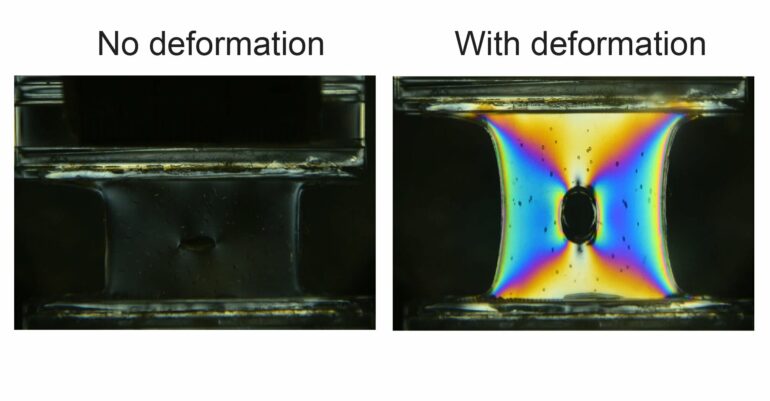Research at Michigan State University is focused on teaching robots to use colors to perceive, visualize, and interpret interactions when manipulating objects. A force-interpreting optical system is being developed so robots can distinguish and manipulate soft and fragile objects—which will be particularly helpful for medical and other assistive robots.
“We’re working to integrate photoelastic gel into a stress-interpreting optical system for vision-based tactile gel-robots,” said Shaoting Lin, assistant professor of mechanical engineering. “Creating this perception for a robot will help it execute ultra-gentle manipulation of soft and fragile objects.”
Lin is the principal investigator and is working with Civil Engineering Assistant Professor Wei Li at Stony Brook University and Industrial Engineering Assistant Professor Yu She at Purdue University.
“Specifically, this project will leverage the molecular design of fatigue-resistant photoelastic gels, the mechanical design of a stress-interpreting photometry system, and the algorithm design of physics-informed machine learning,” he explained.
Researchers have been designing robots with “soft” hands and computer vision systems for years. The technology helps reduce manual labor costs and improves efficiencies in a variety of medical and industrial applications, ranging from surgical robots to apple harvesting.
Lin said teaching assistive robots to use colors will advance their use in everything from collecting fragile jellies for marine studies to better domestic skills in assistive robots for serving food.
“Our long-term goal is to fill the fundamental gap that currently exists between robotic tactile perception and human haptic sensing,” Lin added. “It’s another step in preparing the next-generation of robots.”

An optical system is being developed so robots can better manipulate soft and fragile objects. © Michigan State University
Improving conventional thermal switches
Other research by Lin was recently recognized for its potential application in solid-state refrigeration, thermal memory devices, and thermal metamaterials.
Lin co-authored an article on polymeric thermal switches that was published in Nature Communications. Researchers at the Massachusetts Institute of Technology are collaborating on this project.
“Thermal switches are pivotal for stable temperatures in environments with fluctuating conditions like spacecrafts, vehicles, infrastructures, and batteries,” he said. “High-performing thermal switches can help manage heat in electronic devices, along with temperature control in spacecrafts, and even smart textiles.”
Lin explained that traditional thermal switches that help manage heat in electronic devices usually adjust slowly and have a limited range of control.
“Once their thermal conductivity changes, it’s hard to switch it back. In contrast, the polymer-based thermal switch developed in this work can adjust its thermal conductivity up to 14 times, and it can be reversed easily whenever needed.
“The key mystery is attributed to the unique structure of the polymeric thermal switch, that is composed of nearly ideal polymer-network architecture,” he added.
More information:
Chase M. Hartquist et al, Reversible two-way tuning of thermal conductivity in an end-linked star-shaped thermoset, Nature Communications (2024). DOI: 10.1038/s41467-024-49354-2
Provided by
Michigan State University
Citation:
Teaching robots to use color in moving objects (2024, September 12)



